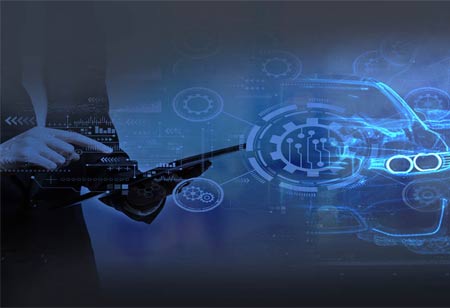THANK YOU FOR SUBSCRIBING
THANK YOU FOR SUBSCRIBING
Be first to read the latest tech news, Industry Leader's Insights, and CIO interviews of medium and large enterprises exclusively from Auto Tech Outlook

By
Auto Tech Outlook | Tuesday, March 14, 2023
Stay ahead of the industry with exclusive feature stories on the top companies, expert insights and the latest news delivered straight to your inbox. Subscribe today.
Future automotive technology will rely heavily on sensors, which may be used in a variety of ways to steer automobiles along their paths and enable features in cockpits that are becoming more and more digital.
FREMONT, CA: Nowadays, sensors serve a variety of purposes and are an essential component of any modern automotive design. They play a crucial role in assisting automakers in bringing safer, more fuel-efficient, and more pleasant vehicles to market. Sensors will eventually allow for higher levels of vehicle automation, which will be advantageous for business.
Intelligent Observation
One of the prerequisites to enable an automobile to behave independently is intelligent observability, in addition, to complete controllability and data processing. Automobiles will need to handle a wide range of parametric data, such as speed, current, pressure, temperature, positioning, proximity detection, gesture recognition, etc., in order to achieve the goal of full visibility. The use of time-of-flight (ToF) cameras and ultrasonic sensors in automobiles has achieved significant advancements in the fields of proximity detection and gesture recognition in recent years.
Ultrasonic Sensors
As vehicle automation advances, individuals are witnessing not only the application of new technologies to the automotive sector for the first time but also the adaptation of mature automotive technologies to the special requirements that autonomous driving will impose. Ultrasonic sensors are currently installed in vehicle bumpers for assisted parking systems. So far, such sensors are only expected to work at speeds less than 10 km/h and are incapable of measuring small distances with 100 per cent accuracy. However, in an autonomous vehicle, such sensors could be used in conjunction with radar, cameras, and other sensing technologies to provide distance measurement functionality.
Gesture Recognition
ToF cameras are focused on the interior of the car, while ultrasonic sensor technology is used to observe the outside world. Drivers must be able to switch from autonomous mode to manual mode in certain circumstances since the transition to autonomous driving will be gradual.
Through the employment of their advanced driver assistance systems (ADAS) mechanisms, cars are now only partially autonomous, but human intervention may be needed at any time. In the upcoming years, it can be anticipated that the sector will move towards higher levels of automation, but even then, the driver will need to be able to take over in specific situations (e.g. when the car is in city centres). It will be a long time before this changes. A vehicle must be able to alert its driver up until that point. Real-time tracking of the driver's location and motion is therefore essential.
Even though it is still in its early stages, ToF technology is already being used today, for example, to alert drivers when they have a moment of distraction that causes the car to drift towards the edge of the road. It also makes it feasible to perform other tasks based on gesture recognition, such as adjusting the radio volume or answering an incoming call with a hand swipe. Yet when driver automation becomes more advanced, the potential application of ToF will go much beyond these sorts of tasks. ToF cameras will be able to map a driver's whole upper body in 3D, making it possible to determine whether the driver is viewing the road ahead with their head position.
3D Mapping of the Traffic Situation
Currently, radar is used by adaptive cruise control systems to measure the distance from the car in front. On motorways, this technique works well, but in cities, where distances are shorter and pedestrians and/or vehicles can approach from several directions, more accurate position measurement is required.
One possibility is to add a camera for improved determination of perspective. Nevertheless, the speed and dependability required to reliably and quickly detect all the critical elements to assure safe driving are well beyond the capabilities of the presently available image processing hardware. This is an area where lidar looks destined to be useful. Lidar is based on measuring the reflection of a sent signal and operates on the same principles as radar. Whereas radar relies on radio waves, lidar makes use of light beams (e.g. laser). The distance to the object or surface is measured by measuring the time that elapses between the transmission of a pulse and when a reflection of that pulse is received.
The main benefit of lidar is that it makes it possible to detect much smaller things than is feasible with radar. When compared to a camera, which sees the world through focus planes, lidar produces a 3D image that is accurate and somewhat detailed. No matter the lighting, this makes it simple to separate items from what is in front of or behind them (day or night). The motivation for adopting this strategy will grow as the price points connected with lidar technology continuously decline and more technological advancement is made.
Next-generation sensors, which are currently being developed, will ultimately define the autonomous driving experience that is being envisioned. The cars of the future will provide a clear, constantly updated picture of what is happening, both concerning the external environment and what their occupants are doing, owing to innovation in the areas outlined in this insight. As a result, sensing technologies hold the key to the automotive industry's future.
 Copyright © 2025 AutoTech Outlook. All Rights Reserved | Privacy Policy | Subscribe | Sitemap | About us | Feedback Policy | Editorial Policy
Copyright © 2025 AutoTech Outlook. All Rights Reserved | Privacy Policy | Subscribe | Sitemap | About us | Feedback Policy | Editorial Policy 



